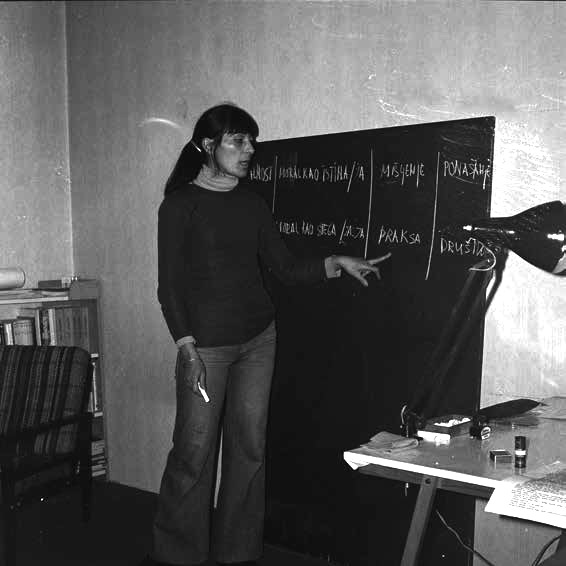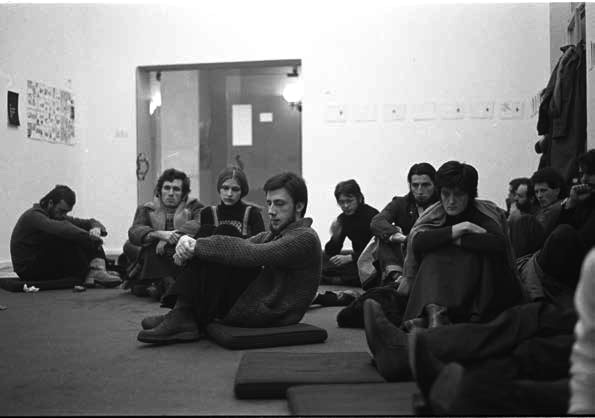For Art as Knowledge Production and Theoretical Inter-Textualism: The Seminars of the Group 143












The Seminar by Group 143 was conceptualized as theoretical artistic event. It was paradigmatic for the work of the group whose main artistic medium was conversation, and as such, events were often presented in the form of artistic seminars and theoretical performances. The Seminar in SKC was an exploration of various formal, semantical, and contextual issues of art placed behind the “surface of visible” of an art object (as the assumed fetish of modernist aestheticism). Artists, critics, and philosophers—members of Group 143 and their guests from Šempas and Zagreb—were interrogating and performing different artistic, philosophical and logical questions, emphasizing process-based work (or thought) and focusing (aesthetically) to the very process of lecturing. Some of the investigations by participants of the Seminar unfolded under titles such as “Specific character of the structure or of the process,” “Specific character of meaning,” “Theory of numbers in the domain of visible-sensible manifestations,” “History of art as the process of education of the humankind,” “The art of nature and the art of man,” and so on.
The Seminar experimented with the concept of art-as-knowledge-production in line with the tradition of analytic Conceptualism in Britain and the United States, but also with the other institutionalized avant-garde forms of artistic education such as the Bauhaus school where the learning of art making coincided with the urge for theoretical reflection on art by the artists themselves. In the similar fashion, the occasion for the artistic talks and investigations where their artworks exhibited in the gallery space in the medium of film, photography, performance, and analytic drawings. Some of the theoretical references, important in the development of Group 143 and the structure of their (internal or public) seminars and workshops, were the writings of Ludwig Wittgenstein and Art & Language, the concept of a “paradigm shift” by Thomas S. Kuhn, Joseph Kosuth’s investment into linguistics, and Germano Celant’s concept of critical critique. The work of the group was oriented toward “non-utilitarity, non-partisanship and ethical, rather than political statements. In other words, the group didn’t support any forms of artistic activism, but rather insisted on theoretical intertextualism.”[1]
Group 143 was established in 1975 by curator and art critic Biljana Tomić, one of the most influential figures in the history of Student Cultural Center (SKC), Belgrade, who became head of the visual arts program at the end of 1975, when Dunja Blažević moved to the directorial position of SKC. Tomić was also one of the editors of the Likovni program of the Belgrade International Theater Festival (BITEF), which was the visual arts program organized by Atelier 212 as an accompaniment to the festival of avant-garde and experimental theater, held in Belgrade since 1967. Within the context of BITEF and Tribune of Youth, both predating the establishment of the SKC gallery, Tomić organized different projects of experimental art, collaborating with early Yugoslav conceptualists (OHO, Braco Dimitrijević, Goran Trbuljak, KOD Group, Group E, etc.), and presenting various actors from the international art scene—from performance artists to protagonists of Arte Povera and Conceptual art (Michelangelo Pistoletto, Jannis Kounellis, Daniel Buren, Germano Celant, Catherine Millet, etc). At the time, Group 143 was joined by young philosophers and artists who were often influenced by analytic philosophy and logical positivism—among these were Jovan Čekić, who later called himself a media theorist and artist, and Miško Šuvaković, who later became a significant theorist of the art of 1960s and 1970s in both the Yugoslav and international context.
Group 143 continued working until the 1980s. One of the reasons why the members of the group dispersed was, according to the statements by its members, the perceived lack of interest in conceptual thinking within contemporary art production at the turn of 1980s, and their refusal to participate in the new “paradigm shift” that lead to the supremacy of painting. This particular period was marked by the return to image and painting, which, in the local context and within the microclimate of SKC, was probably fostered by visits of Achille Bonito Oliva, and promotion of the concept of Transavanguarde by the local critics and curators, including those who supported New Art in the 1970s.
Miško Šuvaković, Konceptualna umetnost (Novi Sad: Muzej savremene umetnosti Vojvodine, 2007), 308.
Date: November 8–11, 1978
Participants: Jovan Čekić, Miško Šuvaković, Paja Stanković, Darko Hohnjec, Igor Leonardi, Maja Savić, Boris Demur, Bojan Brecelj, Biljana Tomić, and Marko Pogačnik
Location: SKC gallery, Belgrade









